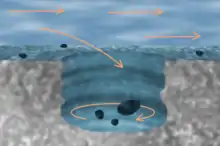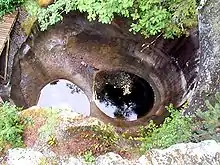Giant's kettle
A giant's kettle, also known as either a giant's cauldron, moulin pothole, or glacial pothole, is a typically large and cylindrical pothole drilled in solid rock underlying a glacier either by water descending down a deep moulin or by gravel rotating in the bed of subglacial meltwater stream.[1]

The interiors of potholes tend to be smooth and regular, unlike a plunge pool. An example is the large pothole found in Archbald, Pennsylvania, in Archbald Pothole State Park.
Formation


Giant's kettles are formed while a bedrock surface is covered by a glacier. Water, produced by the thawing of the ice and snow, forms streams on the surface of the glacier, which, having gathered into their courses a certain amount of morainic debris, finally flow down a crevasse as a swirling cascade or moulin. The sides of the crevasse are abraded, and a vertical shaft is formed in the ice.[2] The erosion may be continued into the bed of the glacier. After the ice departed the area, the giant's kettle formed as an empty shaft, or as a pipe filled with gravel, sand, or boulders. Such cavities and pipes afford valuable evidence as to the former extent of glaciers.[3]
Similar potholes are encountered in riverbeds and the Channeled Scablands scoured by glacial outburst floods.[4]
Notable giant's kettle
Helvete in Gausdal, Norway is a gill about 100 meters deep with giant's kettles (jettegryter) up to 20 m (66 ft) wide and 60 m (200 ft) deep.[5] The GletscherGarten of Lucerne (Switzerland) is famous for its giant's kettles, having 32 in number, the largest being 8 m (26 ft) wide and 9 m (30 ft) deep.
They are also common in Germany (gletschertopf; glacier pot), Sweden (jättegryta), Finland (hiidenkirnu; hiisi's churn), and Moss Island in the United States.[3]
See also
References
- Neuendorf, K.K.E., J.P. Mehl, Jr., and J.A. Jackson, eds. (2005) Glossary of Geology (5th ed.). Alexandria, Virginia, American Geological Institute. 779 pp. ISBN 0-922152-76-4
- "Archived copy" (PDF). Bulletin of the Massachusetts Archaeological Society. XIV (4): 112. July 1953. Archived from the original (PDF) on 30 January 2016. Retrieved 12 July 2010.
{{cite journal}}: CS1 maint: archived copy as title (link) - Chisholm 1911.
- Baker, Victor (2010). Migon, Piotr (ed.). Channeled Scablands: A Megaflood Landscape, in Geomorphological Landscapes of the World. Springer. pp. 21–28. ISBN 9789048130542.
- Mæhlum, Lars (15 February 2021). "Helvete (elvegjel i Gausdal)". Store norske leksikon. Retrieved 23 April 2022.
- This article incorporates text from a publication now in the public domain: Chisholm, Hugh, ed. (1911). "Giant's Kettle". Encyclopædia Britannica. Vol. 11 (11th ed.). Cambridge University Press. p. 927.
